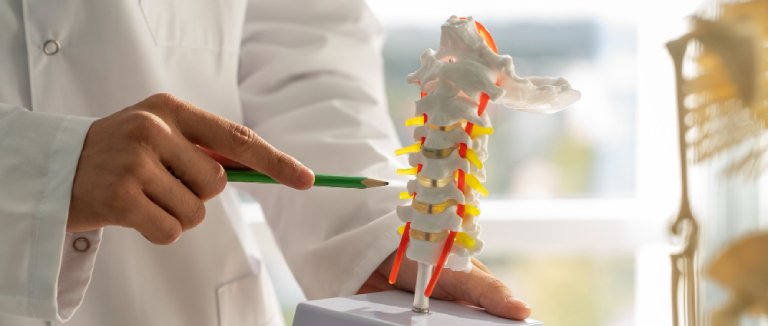Mild scoliosis is characterized by a sideways curvature of the spine measuring between 10 and 25 degrees, impacting millions of individuals worldwide. Although its exact cause often remains unknown, mild scoliosis typically appears during rapid growth phases in childhood. Most cases do not require extensive treatment; however, understanding the condition”its symptoms, methods of diagnosis, and available management options”is essential for early detection and effective care.

Understanding the Spine and Condition
The human spine is a remarkable structure made up of 24 vertebrae that provide essential support and enable flexibility for movement and posture. In cases of mild scoliosis, the spine curves into an "S" or "C" shape, departing from its normal alignment. This abnormal curvature may develop in either the thoracic (upper back) or lumbar (lower back) regions.
Recognizing Symptoms
Symptoms of mild scoliosis can often be subtle and less obvious compared to more severe cases. Early recognition and timely action are crucial, as awareness plays a key role in prompt diagnosis. Individuals with mild scoliosis may notice:
Subtle Spinal Curvature: The hallmark of mild scoliosis is a gentle, sideways curve of the spine that is often more noticeable when the individual bends forward.
Mild Shoulder or Hip Height Imbalances: Subtle differences in shoulder or hip height may be present, though these imbalances are often slight and can easily go unnoticed.
Mild Back Pain or Discomfort: Some individuals may notice occasional discomfort or mild back pain, particularly after extended periods of sitting or standing.
Is It a Disability?
Understanding the nature of mild scoliosis is critical for those diagnosed with it. It refers to a slight curvature of the spine, usually less than 20 degrees. While it may not pose an immediate threat to health, it does necessitate attention and monitoring to ensure that it does not spread.
Mild scoliosis is classified as a disability based on several factors, including the degree of curvature, associated symptoms, and the impact on daily life. Individuals with mild scoliosis often lead active, fulfilling lives with few restrictions. However, if the curvature worsens or the associated symptoms are severe, it may impair mobility and quality of life, potentially necessitating disability consideration.

Exploring Treatment Options for Mild Scoliosis
Although mild scoliosis typically involves a less pronounced spinal curvature than moderate or severe cases, it is important to explore available treatment options. Early intervention can help prevent progression of the condition. Treatment for mild scoliosis may include:
Observation and Monitoring: When the curvature is small and remains stable, healthcare providers may recommend regular observation”also known as a "watch-and-wait" approach”to monitor any potential changes over time.
Physical Therapy and Exercises: Specific exercises play a key role in the management of mild scoliosis. Tailored exercise programs help strengthen core muscles and promote better spinal alignment, which can reduce discomfort and prevent further curvature progression.
Exercises for mild thoracic scoliosis are aimed at increasing mobility and flexibility in the upper back region.
Exercises for mild lumbar scoliosis are designed to strengthen the muscles of the lower back, providing better support and improved spinal stability.
Exercises for mild thoracolumbar scoliosis are tailored to address both the upper (thoracic) and lower (lumbar) segments of the spine, enhancing overall flexibility and stability.
Bracing: In certain cases, particularly when the individual is still growing, a brace may be prescribed to help prevent further progression of the spinal curvature.
For more information about mild scoliosis treatment options in Türkiye, reach out to the experts at Liv Hospital in Istanbul.
Adults and Lifestyle Care
Contrary to popular belief, scoliosis does not only occur during adolescence. Mild scoliosis in adults can result from several factors, including the progression of a childhood condition or the development of degenerative changes in the spine over time.
The primary goals for adults with mild scoliosis are to manage symptoms and prevent further curvature progression. To improve overall spinal health and alleviate discomfort, physical therapy, tailored exercises, and, in some cases, pain management strategies may be used.
Adopting Proactive Lifestyle Strategies
Taking a proactive approach to health is vital for individuals with mild scoliosis. Regular check-ups, following prescribed exercise routines, and maintaining a healthy lifestyle all play an important role in supporting long-term well-being.
Regular check-ups: Scheduling regular visits with a spine specialist or orthopedic doctor helps detect any changes in spinal curvature early, enabling timely adjustments to your treatment plan.
Consistent Exercise Routine: Incorporating prescribed exercises into your daily routine supports spinal health and helps prevent further progression of the curvature.
Balanced Diet: Maintaining a well-balanced diet, staying properly hydrated, and achieving a healthy body weight are essential factors in managing mild scoliosis and supporting overall health.
Empowering Perspectives on Living with Mild Scoliosis

Understanding and managing mild scoliosis necessitates a combination of education, proactive healthcare, and tailored interventions. Individuals with mild scoliosis can live fulfilling lives with minimal impact on their daily activities by recognizing the symptoms, seeking timely treatment, and adopting a proactive approach to spinal health. Remember that early intervention is critical; staying informed allows people to make educated decisions about their health and well-being.
Living with mild scoliosis does not imply accepting limitations but encourages individuals to embrace empowerment and resilience. While the physical aspects of the condition are important, the mental and emotional dimensions are also critical.
Developing a Positive Attitude
People with mild scoliosis often discover resilience through a positive outlook. Recognizing that the condition is manageable”and that proactive steps make a difference”can foster a strong sense of control. This shift in mindset is a powerful tool for navigating the challenges associated with scoliosis.
Creating a Helpful Network
Sharing experiences with friends, family, or others facing similar challenges through support groups can provide insights, encouragement, and a sense of camaraderie.
Contact Liv Hospital experts in Istanbul if you want mild scoliosis treatment in Türkiye!
Accepting Individuality
Recognizing that each person's experience with mild scoliosis is unique is fundamental. Embracing individuality”and remembering that your condition does not determine your worth or abilities”can foster a healthier and more positive self-image.
Liv Hospital for Mild Scoliosis Treatment in Türkiye
As you navigate the complexities of mild scoliosis management, remember that it's not just about addressing the physical aspects but also about fostering holistic well-being. Individuals with mild scoliosis can confidently stride towards a future marked by resilience, empowerment, and overall health by taking a proactive approach, maintaining a positive mindset, and building a supportive community.
Regarding health tourism in Türkiye, Liv Hospital provides a distinct blend of excellence and international standards. Liv Hospital, with a network of 10 hospitals across Türkiye and the World, is at the forefront of shaping the future of healthcare. The institution prioritizes global health perfection, as evidenced by its name, derived from the initials of the slogan "Leading International Vision." Liv Hospital is distinguished by its dedication to providing world-class medical services, making it an ideal choice for those seeking top-tier healthcare facilities and expertise in the heart of Türkiye. Contact Liv Hospital experts to learn more about mild scoliosis treatment prices in Türkiye in 2025!
* Liv Hospital Editorial Board has contributed to the publication of this content .
* Contents of this page is for informational purposes only. Please consult your doctor for diagnosis and treatment. The content of this page does not include information on medicinal health care at Liv Hospital .
For more information about our academic and training initiatives, visit Liv Hospital Academy
Frequently Asked Questions
What is mild scoliosis?
Mild scoliosis is a sideways curvature of the spine measuring between 10 and 25 degrees. It often develops during childhood growth spurts and usually causes minimal symptoms.
Is mild scoliosis a serious condition?
In most cases, mild scoliosis is not serious and can be effectively managed with observation, exercise, and physical therapy. However, regular monitoring is essential to prevent progression.
Can mild scoliosis get worse over time?
Yes, especially during growth phases or in adulthood due to degenerative spinal changes. Regular follow-ups with a spine specialist help track any progression.
What are the main symptoms of mild scoliosis?
Subtle spinal curvature, uneven shoulders or hips, and occasional mild back pain or stiffness are common signs. In many cases, symptoms are hardly noticeable.
How is mild scoliosis diagnosed?
Diagnosis typically involves a physical examination and imaging tests such as X-rays to measure the degree of spinal curvature.
What treatments are available for mild scoliosis?
Most cases are managed through observation, posture correction, and targeted exercises to strengthen the back and core muscles. In some growing children, a brace may be recommended.
Can exercise help mild scoliosis?
Yes. Regular stretching and strengthening exercises, especially those focused on core and back muscles, can improve posture, reduce discomfort, and help maintain spinal balance.
Is mild scoliosis considered a disability?
Usually, mild scoliosis does not qualify as a disability since it rarely limits mobility or daily activities. Only severe or symptomatic cases may be considered disabling.
Can adults develop mild scoliosis?
Yes. Adults can develop mild scoliosis due to aging, degeneration, or untreated childhood scoliosis that progresses over time.
Where can I get mild scoliosis treatment in Türkiye?
Liv Hospital in Istanbul offers advanced diagnostic and therapeutic options for mild scoliosis, including physical therapy, custom exercise programs, and lifestyle guidance designed for long-term spinal health.
